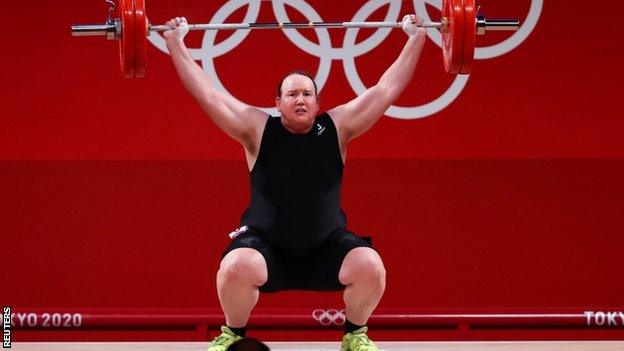International Olympic Committee releases new framework on transgender inclusion
- Published

At Tokyo, Laurel Hubbard became the first transgender athlete to compete at the Olympics in a different gender category to that in which they were born
New guidance from the International Olympic Committee (IOC) says there should be no assumption that a transgender athlete automatically has an unfair advantage in female events.
Its new framework on transgender inclusion, released on Tuesday, places responsibility on individual federations to determine eligibility criteria in their sport.
The 10-point document is "not legally binding" and not every sport is expected to find a solution before Paris 2024.
The framework, which replaces IOC guidelines issued in 2015, also changes the policy on requiring transgender women to suppress testosterone levels in order to compete in female events.
The old policy that said transgender athletes would be allowed to compete provided their testosterone levels were below a certain limit for at least 12 months before their first competition.
Relying on testosterone levels alone in female events is no longer deemed sufficient grounds to determine whether or not a competitor has an unfair advantage.
"You don't need to use testosterone [to decide who can compete] at all. But this is guidance, it's not an absolute rule," said IOC medical director Richard Budgett.
The framework was prepared over two years in consultation with more than 250 athletes and other stakeholders, and will be implemented after next year's Beijing Winter Games.
"What we are offering to all the international federations is our expertise and a dialogue, rather than jumping to a conclusion," said Kaveh Mehrabi, director of the IOC's athletes' department.
"This is a process that we have to go through with each federation on a case-by-case basis and see what is required."
The IOC's new framework also applies to athletes with differences of sex development (DSD) such as the South African 800m runner Caster Semenya.
Governing body World Athletics defended its existing policy, which forces DSD athletes to suppress their testosterone levels to compete in certain events, citing the rejection of Semenya's challenge of the rules by the Court of Arbitration for Sport in 2019.
Its statement read: "To the extent the IOC document diverges from our regulation, we would simply note that the Court of Arbitration for Sport panel in 2019 found that the DSD regulations were a necessary, reasonable, and proportionate means of achieving World Athletics' legitimate objective of maintaining fair and meaningful competition in the female category."
The IOC also said medical testing and "invasive physical examinations" used to verify an athlete's gender were "disrespectful" and "potentially harmful".
"We really want to make sure that athletes are not pressured or coerced into making a harmful decision about their bodies," said Magali Martowicz, IOC head of human rights.
The guidance stresses that athletes should be part of the decision-making process.
It adds that restrictions should be based on robust credible research and that sports should follow all the criteria to prove a disproportionate advantage or safety risk exists.
"The IOC recognises that it must be within the remit of each sport and its governing body to determine how an athlete may be at a disproportionate advantage compared with their peers, taking into consideration the nature of each sport," reads the framework.
"The IOC is therefore not in a position to issue regulations that define eligibility criteria for every sport, discipline or event across the very different national jurisdictions and sport systems."